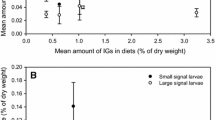Abstract
We reared larvae ofJunonia coenia Hubner (Nymphalidae) on artificial diets with trace concentrations of iridoid glycosides and on leaf diets with higher concentrations of iridoid glycosides. We offered these caterpillars to predacious ants and observed the effects of the following on predation: diet (artificial vs. leaf), site (ant colonies in dry vs. wet areas), instar (early vs. late), and time (changes in predation over five days). Diet and site were consistently significant predictors of the ants' propensities to reject prey and the caterpillars' abilities to escape predation. Leaf-diet caterpillars escaped more frequently than artificial-diet caterpillars, and ants from dry sites were more likely to reject prey than ants from wet sites. The percentage of iridoid glycosides found in individual caterpillars was also a good predictor of the probability of rejection by predators and prey escape. Caterpillars with higher levels of iridoids were more likely to be rejected and to escape, suggesting that sequestered iridoid glycosides are a defense against predaceous ants.
Similar content being viewed by others
References
Bernays, E. A. 1988. Host specificity in phytophagous insects: Selection pressure from generalist predators.Entomol. Exp. Appl. 49:131–140.
Bernays, E. A., andCornelius, M. L. 1989. Generalist caterpillar prey are more palatable than specialists for the generalist predatorIridomyrmex humilis.Oecologia 79:427–430.
Bobbitt, J. M., andSegebarth, D. P. 1969. Iridoid glycosides and similar substances, pp. 1–145,in W. I. Taylor and A. R. Battersby (eds.). Cyclopentanoid Terpene Derivatives. Academic Press, New York.
Bowers, M. D. 1984. Iridoid glycosides and host-plant specificity in larvae of the Buckeye butterfly,Junonia coenia (Nymphalidae).J. Chem. Ecol. 10:1567–1577.
Bowers, M. D. 1991. Iridoid glycosides, pp. 297–326,in G. A. Rosenthal and M. R. Berenbaum (eds.). Herbivores: Their Interactions with Secondary Plant Metabolites. Academic Press, New York.
Bowers, M. D. 1992. The evolution of unpalatability and the cost of chemical defense in insects, pp. 216–244,in B. D. Roitberg and M. B. Isman (eds.). Insect Chemical Ecology: An Evolutionary Approach. Chapman & Hall, New York.
Bowers, M. D., andCollinge, S. K. 1992. Fate of iridoid glycosides in different life stages of the buckeye,Junonia coenia (Lepidoptera: Nymphalidae).J. Chem. Ecol. 18:317–331.
Bowers, M. D., andLarin, Z. 1989. Acquired chemical defense in the lycaenid butterfly,Eumaeus atala.J. Chem. Ecol. 15:133–146.
Bowers, M. D., andStamp, N. E. 1993. Effects of plant age, genotype, and herbivory onPlantago performance and chemistry.Ecology 74:1778–1791.
Brower, L. P. 1984. Chemical defense in butterflies, pp. 109–134,in R. I. Vane-Wright and P. R. Ackery (eds.). The Biology of Butterflies: Symposium of the Royal Entomology Society Number 11. Academic Press, New York.
Cherin, D., andBourne, J. D. 1980. A field-study on a supercolony of the red wood antFormica lugubris Zett. in relation to other predatory Arthropods (spiders, harvestmen and ants).Rev. Suisse Zool. 87:955–973.
Christensen, R. 1990. Log-linear models. Springer-Verlag, New York.
Dejean, A. 1988. Prey capture byCamponotus maculatus (Formicidae - Formicinae).Biol. Behav. 13:97–115.
De la Fuente, M. A., Dyer, L. A. andBowers, M. D. 1994. The iridoid glycoside, catalpol, as a deterrent to the predatorCamponotus floridanus (Formicidae).Chemoecology 5:13–19.
Duff, R. B., Bacon, J. S. D., Mundie, C. M., Farmer, V. C., Russell, J. D., andForrester, A. R. 1965. Catalpol and methylcatalpol: Naturally occurring glycosides inPlantago andBuddleia species.Biochem. J. 96:1–5.
Duffey, S. S. 1980. Sequestration of plant natural products by insects.Annu. Rev. Entomol. 25:447–477.
Dyer, L. A. 1995. Tasty generalists and nasty specialists? Antipredator mechanisms in tropical lepidopteran larvae.Ecology 76:1483–1496.
Dyer, L. A., andFloyd, T. 1993. Determinants of predation on phytophagous insects: The importance of diet breadth.Oecologia 96:575–582.
Feinberg, S. E. 1970. The analysis of multidimensional contingency tables.Ecology 51:417–433.
Gardner, D. R., andStermitz, F. R. 1988. Hostplant utilization and iridoid glycoside sequestration byEuphydryas anicia individuals and populations.J. Chem. Ecol. 15:2147–2168.
Hagen, K. S., Bombosch, S., andMcMurtry, J. A. 1976. The biology and impact of predators, pp. 93–142,in C. B. Huffaker and P. S. Messenger (eds.). Theory and Practice of Biological Control. Academic Press, New York.
Hölldobler, B., andWilson, E. O. 1990. The Ants. Belknap Press, Cambridge, Massachusetts, p. 534.
McIver, J. D. andLoomis, C. 1993. A size-distance relation in Homoptera-tending thatch ants (Formica obscuripes, Formica planipilis).Insectes Soc. 40:207–218.
Nishida, R., andFukami, H. 1989. Host plant iridoid-based chemical defense of an aphid,Acyrthosiphon nipponicus, against ladybird beetles.J. Chem. Ecol. 15:1837–1845.
Reavey, D. 1993. Why body size matters to caterpillars, pp. 248–279,in N. E. Stamp and T. M. Casey (eds.). Caterpillars: Ecological and Evolutionary Constraints on Foraging. Chapman & Hall, New York.
Rothschild, M. 1977. Storage of cannabinoids byArctia caja andZonocerus elegans fed on chemically distinct strains ofCannabis sativa.Nature 266:650–651.
Rothschild, M., Aplin, R. T., Cockrum, P. A., Edgar, J. A., Fairweather, P., andLees, R. 1979. Pyrrolizidine alkaloids in arctiid moths (Lep.) with a discussion on host plant relationships and the role of these secondary plant substances in the Arctiidae.Biol. J. Linn. Soc. 12:305–326.
Skinner, G. J., andWhittaker, J. B. 1981. An experimental investigation of inter-relationships between the wood-ant (Formica rufa) and some tree-canopy herbivores.J. Anim. Ecol. 50:313–326.
Stamp, N. E. 1992. Relative susceptibility to predation of two species of caterpillar on plantain.Oecologia 92:124–131.
Author information
Authors and Affiliations
Rights and permissions
About this article
Cite this article
Dyer, L.A., Deane Bowers, M. The importance of sequestered iridoid glycosides as a defense against an ant predator. J Chem Ecol 22, 1527–1539 (1996). https://doi.org/10.1007/BF02027729
Received:
Accepted:
Issue Date:
DOI: https://doi.org/10.1007/BF02027729




